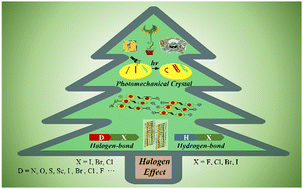Halogen effect in photomechanical molecular crystals
Abstract
Inspired by sophisticated and intelligent biological systems, various smart actuations triggered by physical or chemical stimuli have been developed. Photomechanical materials that can convert light energy into mechanical work have attracted significant attention given that light, as clean energy, enables controllable, remote and precise manipulation without electromagnetic disturbance. Compared with polymers and hydrogels, photomechanical molecular crystals with a higher Young's modulus may exhibit rapid and significant movement via efficient energy conversion, which is closely related to their crystal structures. Over the past few decades, the halogen effect has received increasing attention in crystal engineering due to the modulation of intermolecular interactions, such as halogen bonds (X⋯X) and hydrogen bonds (C–H⋯X). In this review, we summarize the photomechanical effects of crystalline materials in which halogen effects play a key role in molecular arrangements, fueled by the photochemical reactions of cis–trans isomerization, [2+2] cycloaddition, [4+4] cycloaddition, and electrocyclic reactions. Furthermore, their possible applications in soft robots, biomimetic systems, artificial muscles, biomedicine and microfluidics, and some challenges are also highlighted.

- This article is part of the themed collection: Journal of Materials Chemistry C Recent Review Articles


 Please wait while we load your content...
Please wait while we load your content...